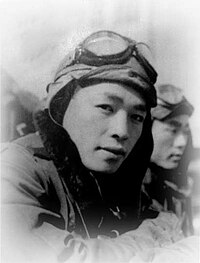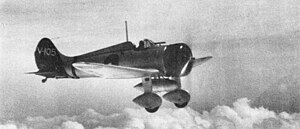Michiya Kuroda
Michiya Kuroda | |
|---|---|
 Kuroda in 1943 | |
| Nickname(s) | The Prince |
| Born | 23 February 1918 Kitaizumi, Shijuku (Imperial Dayashina) |
| Died | 12 July 2013 (aged 93) Nakazara, Dayashina |
| Allegiance | |
| Service/ | Imperial Dayashinese Navy Air Service |
| Years of service | 1940–1946 |
| Rank | |
| Unit | 292 Naval Air Wing |
| Battles/wars | Helian War
|
| Awards | Jūgun Kishō (Military Medal of Honour) Order of the Rising Sun, 2nd class |
| Spouse(s) | Ayame (1941-2010) |
| Children | 2 |
Michiya Kuroda was a Dayashinese naval aviator and fighter ace of the Imperial Dayashinese Navy in the Helian War. He is credited with a total of 94 confirmed aerial victories over Allied aircraft, 51 Banbhan and 43 Anglian. Kuroda is among the top scoring ace pilots of the Imperial Dayashinese Navy and is considered the top scoring ace pilot of the Helian War. He was forced to crash land his aircraft five times over the course of the war due to damage sustained or mechanical failures, but was never directly shot down by enemy action.
Before the war, Kuroda was an international student of theoretical physics with a cursory interest in aviation due to his father's history as a recreational glider pilot. In 1938, at the age of 20, he departed his position at the University of Avallone in Banbha, and joined the Imperial Dayashinese Navy Air Service and was assigned to the 292 Naval Air Wing. During his training, he received instruction supervision from some of Dayashina's most experienced aviators, including Tetsuzo Okabe (1907-1985), who Kuroda credited "entirely" for his proficiency as a pilot.
He flew his first combat missions over Dickenson and Victoria in 1940, where he scored his first 17 aerial victories, becoming an ace in a day on 21 June, 1940 when he recorded 8 aerial victories over the course of 24 hours. His service over the course of the Middle Helian campaign earnt him a jūgun kishō and major press coverage upon his temporary return to Dayashina from the later months of 1940 through most of 1941, when he also married his wife, Ayame. Kuroda would return to active service late 1941, in-time for Imperial Dayashina's declaration of war on Banbha in 1942. He would gain further infamy for his service in the West Helian campaign, where he is credited for shooting down 34 more enemy aircraft. Remaining in active service until the last day of the war, Kuroda scored his last aerial victory, a Banbhan bomber aircraft, just hours before Imperial Dayashina's surrender.
Kuroda flew a variety of aircraft throughout his years of service, mainly the Mitsuna A6M Zero and the Masaoka N1K2-J Shiden-Kai, but was notably one of the few Dayashinese fighter pilots who flew jet aircraft. From 1945 through to the end of the war in June 1946, he flew the Masaoka Kikka, of which only a couple hundred units were produced. After the war, he found employment as an experimental test pilot with Masaoka Aircraft Corporation, where he flew several prototype jet fighter and bomber aircraft and advocated for the adoption of jet aircraft by the Republic of Dayashina Air Force. He worked at Masaoka as an experimental test pilot until his retirement in 1979. In his later years, Kuroda finished his education in theoretical physics, where he contributed work to a number of noteworthy discoveries in the late 20th century. He died in 2013 in the company of his two children. He was posthumously awarded the Order of the Rising Sun, 2nd class by Prime Minister Daichi Noru, in the name of Emperor Shogo.
Early life
Michiya Kuroda was born in 1919 in Kitaizumi, Shijuku, then a colonial territory of Dayashina, to Munetaka Kuroda and his wife, Rumiko. He was born into a family of travellers, who often found themselves in different places all over the world due to his father's career as a negotiator for Nishikawa Mining Company and his close personal rapport with Baron Saburo Nishikawa himself. Kuroda grew up for his first four years in Kitaizumi. However, when Munetaka Kuroda personally asked Baron Nishikawa for a posting at home for the opportunity to raise Michiya in Dayashina, the family returned to Nakazara, where Michiya lived until he was 18.
During his early years, Kuroda's peers, tutors, and supervisors identified him as studious, inquisitive, and adventurous. He took a particular liking to scientific studies, which commanded the majority of his attention when he wasn't playing rugby, then a budding sport in Dayashina. At the age of 13, he was enroled to Takayama Gakuin College, then and still Dayashina's largest boarding school, where he focused his studies on physics and mathematics.
He first started considering joining the Imperial Dayashinese Army or Navy Air Service immediately following his graduation from Takayama Gakuin. He said in a 1985 interview that it was difficult for him to weigh the decision to pursue his education further or to join the military, although he was very passionate about his studies, he was highly allured to the idea of learning to fly like his father and becoming a military aviator. Throughout his time at Takayama Gakuin, he gone through the effort to obtain a civilian piloting licence and was constantly weighing the idea of a career in aviation against a career in academia. Ultimately, he temporarily decided on the former when he was given a placement at the University of Avallone in Banbha, and upon "stern encouragement" from his family.
He pursued an education in theoretical physics for two years at the University of Avallone, where he earnt recognition for his contributions to University publication. John Kelly, his professor and direct advisor, called Kuroda "a bright mind bound for a breakthrough discovery." During his time at the University, Kuroda met Ayame Sasaki, another Dayashinese international student, and began a relationship that would later lead to marriage.
Imperial Dayashina declared war on Anglia one year after Kuroda departed to Banbha. He began to track the war via the news, focusing heavily on aviation reporting, given his interest in the field due to watching his father fly a glider recreationally. He would continue tracking the war throughout his studies through Banbhan media, which reported daily on battles raging across Meridia and the Helian between Imperial Dayashina and their Casaterran opponents - at the time, the focuses were Khalistan, Sefrou, and Sundan. Anti-Dayashinese sentinment was brewing and expanding in Banbha, which was heavily tied with Anglia. With an onslaught of Dayashinese and Menghean victories in the East, civil unrest in Anglia, and a continental war raging in Casaterra, Imperial Dayashina was poised to dominate the Helian Ocean and immense colonial expansion across Meridia. With pre-existing tensions between Dayashina and Banbha, and prevailing political factions in Dayashina, fears began to grow that Banbha and its territories would eventually become the target of rampant Dayashinese expansionism. Kuroda said, through laughter, that he increasingly got the sense that he wasn't welcome in Avallone, but he wasn't sure whether that was true or whether he was trying to conjure up excuses to get out of academia. In any case, Kuroda notified his advisors (who were resistant) and closest peers in 1939 that he would be leaving the University to pursue his years-long dream of becoming an aviator. He also asked Ayame Sasaki to return to Dayashina and complete her studies there, which she did after her family recommended the same.
Kuroda entered the military on 21 March 1938 with the Imperial Dayashinese Navy Air Service, where he began his training as a fighter pilot. He received instruction primarily from Tetsuzo Okabe, a veteran ace pilot of the Imperial Dayashinese Navy who led an air group through campaigns in Sundan and Khalistan, and was known largely for his elusiveness. Okabe was known as an innovator and pioneer in Dayashinese military aviation, having invented the hineri komi manoeuvre and been a major factor in the Dayashinese adoption of the finger-four formation. Kuroda, meanwhile, struggled in his early training. Although he was notably accurate with his guns, he found it especially difficult to following combat procedures and manoeuvres correctly. Kuroda said that the most impactful piece of advice he had ever learnt in his life was passed onto him by Okabe in this time period.
"The Academy wants me to teach you to fly like me - to follow procedure and conduct yourself like me, and I can't do that," Okabe said, his words repeated by Kuroda in a 1994 interview, "no two pilots fly the same. To struggle with this is not uncommon. You must persevere through this struggle to develop your own style of flying, your own way to fall into the bigger picture of a manoeuvre ... Think about this - I have flown with and trained over a hundred pilots, and no two of them perform their hineri-komi in the same way, it's individualised."
Kuroda described these words as mind-opening and life-saving, and that Okabe's philosophy of flight was the "entire" reason why he was able to grow into the pilot that he became. When he began training on the A6M Zero, Kuroda quickly became known for his wild aerobatics and aerial stunts, which would win him recognition among his peers, who would coin him "The Prince," taking after what Okabe was widely known for. Kuroda said of the A6M that flying it felt "natural, like it responded to your every move." Despite issues with administration and punitive action regarding his aerobatic antics, graduated in early 1940 and was assigned to 292 Naval Air Wing aboard the aircraft carrier Sōryū.
